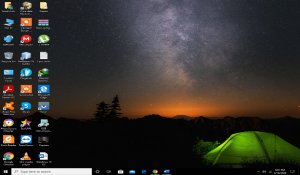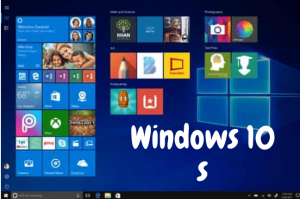Windows 10 operating system
What is the Windows 10 operating system?
Windows 10 is indeed a collection of Microsoft developed and published operating systems that are part of the Windows NT community. This is the replacement to Windows 8.1, launched almost two years ago, which was launched and published to business on July 15, 2015, which was widely published on July 29, 2015.

Figure 1. Window 10 OS
Windows 10 security.
Microsoft has incorporated functionality for applications for multi-factor authentication, like payment cards and coins. Furthermore, auto-brightness added biometric security to Windows 10, enabling users to sign in via fingerprint scanning, iris scanning, or face recognition. The operating system also provides security mechanisms focused on virtualization, like insular User Mode, Windows Defender System Protection, and its firewall accreditation Protection. These aspects of is to hold data, processes, and login information separated in an effort to limit the harm of any assault.
Understanding Windows 10 Editions.
Besides SKUs, Microsoft also provides different architectures for Windows which target your PC’s CPU. I.e., variants 32 and 64-bit. Specifically, the strength is defined according to how much space the machine can handle. The more memory you have, the more programs you can run, the more activities you can perform simultaneously. Many versions do refer to computers with additional CPU slots. Within this post, we look at the SKUs (editions), designs, and build numbers for Windows 10. It is known as the company’s last major product. Microsoft will switch to a more service-oriented model, putting in incremental improvements over time as they’re ready in whatever is known as new releases.
What is the difference between windows 10 pro and home edition?
It turns out it is a wide family of versions, but Home and Pro are the two models’ users who would be most drawn to. Microsoft has extended the product to also include unique versions of which you can read further in the following.
Windows 10 home edition.
Windows 10 Home is the fundamental edition. It arrives with some additional features such as the refurbished Start Menu. The company agreed to chop it off 8th edition three years ago, but this feature returns to the desktop operating system on common demand. This version does not contain certain help businesses functionality such as remote access, Group Policy Manager, Domain Join, Language Packs, Hyper-V.
Windows 10 Pro edition.
Pro is the premium business version that offers advanced features including such multi-processor support, RAM over 512 GB, Group Regulation, Network Backup, Virtual Desktop, Domain Connect, and Hyper-V. In comparison to all the functionality of the Home version, the Pro edition provides advanced networking and security resources such as the Business Mode Internet Explorer (EMIE), Delegated Access 8.1, Wireless Desktop, Direct Access, and Hyper-V client.
Windows 10 S.
The “S” does not stand in general for something as per Microsoft, but the government claims that is S is optimized for ease, safety, and acceleration. The S boots 15 seconds faster than a similar computer running on Pro with the same profile and applications enabled, and runs as quickly on day 1,000 as on day one, says Microsoft. The big difference between S and every other edition of Windows 10 is that 10 S could only operate downloaded applications from the Windows Store. Any other version of Windows 10, like most versions of Windows before everything, has the permission to configure applications from third party websites and stores. The S will also arrive with Microsoft’s BitLocker authentication program to protect your files in the event of theft which is not included in some versions of Home. It’ll also offer the very same updates as all editions at the very same time.

Figure 2. Window 10 S
Enterprise.
Windows 10 Enterprise is the premium business version of Microsoft and is included in its users to sign programs. This version contains all Education and Pro functionality but allows device and system administrators to restrict access to other apps like the Windows Store as well as other consumer experiences. Cortana can also be activated but is already impaired in the Enterprise version in some cases. Apps include Microsoft Configuration Security, AppLocker, Microsoft User Environment application development, Direct Access, Application Défense, Credential Défense, Windows advanced threat Security, Windows to just go, BranchCache, Windows Desktop Optimization Pack. The Enterprise offers all of the Pro’s functionality, including extra enhancements to support That now-based organization. The Enterprise is customizable for Semi-Annual Server, Semi-Annual platform (designed to target), and Windows Update, three branches.
Team.
Windows 10 Team is a customized version that provides a range of custom collaborative tools and features that are available exclusively on the Windows Surface Platform. Team is yet another Enterprise edition, optimized for widescreen computers. It eliminates many of the customer’s desktop functionality and is tailored to situations where touch input is essential. Also customized hardware like Microsoft’s Surface Hub which contains either a 55 / 84-inch display can be seen on Windows 10 Teams. Surface Hub Team is realistic for meet-room companies where meetings, coming up with ideas, and video conferencing are offered.
For the internet of things.
Windows 10 for the Internet of Things is the main stand-out but primarily aimed at embedded IoT devices, while Enterprise / Mobile Enterprise will push ATMs, POS and miniature robots, IoT Core will concentrate on the industrial sector such as gateway devices. That was a lot to take in, of course, so that we can cater to everyone at Assured Systems and if you want more tailor-made guidance to get in touch, we are certified Windows Embedded Partner and can guide you in the right direction nationally. For windows, indeed, it seems to be a real declaration of purpose not only for the IoT where they aim to solidly implement their market position in a $1.9 trillion market due to 3-fold expansion over 2020 with third party versions of OS, as well as for the wider market as they try to regain gained territory in some areas of the state while building on their embedded supremacy in the others.